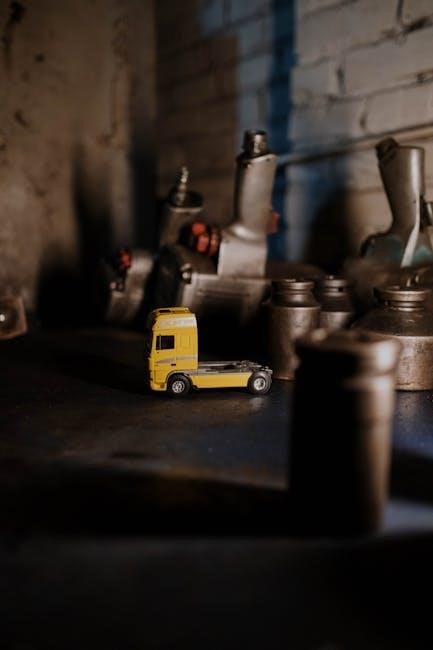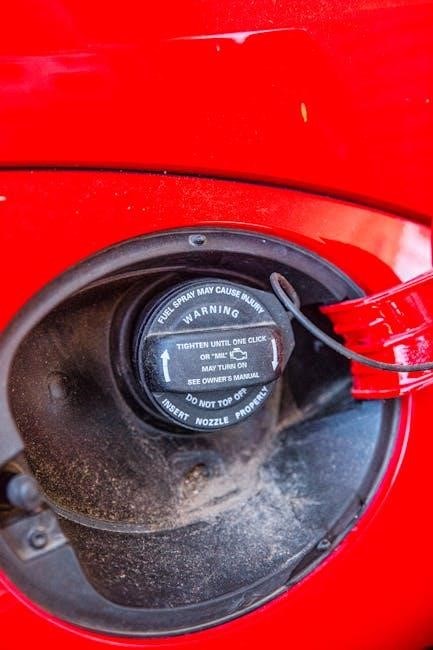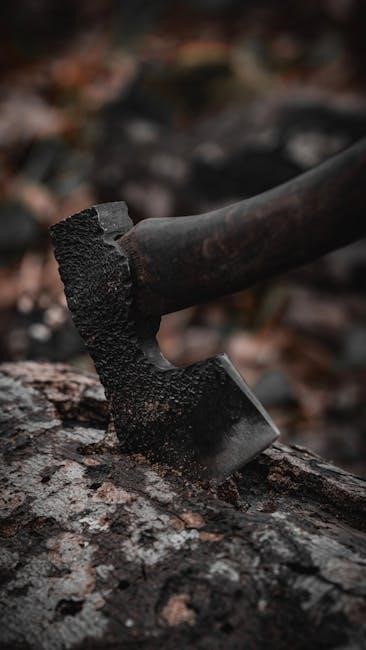The Dixie Chopper Parts Manual serves as a comprehensive guide for owners and technicians‚ providing detailed information on maintenance‚ repair‚ and replacement of parts for Dixie Chopper mowers.
1.1 Overview of the Dixie Chopper Parts Manual
The Dixie Chopper Parts Manual is a detailed guide designed to assist users in understanding‚ maintaining‚ and repairing their Dixie Chopper mowers. It covers models such as the Pursuit 1832S‚ 1836S‚ 1836D‚ and 1844D‚ providing essential information for optimal performance. The manual is structured to help users identify parts‚ perform routine maintenance‚ and troubleshoot common issues. It includes sections on product identification‚ safety precautions‚ and maintenance requirements‚ ensuring that users can keep their equipment in top condition. By following the manual‚ users can extend the lifespan of their mower and ensure safe‚ efficient operation. The guide is intended for both novice and experienced users‚ offering clear instructions and diagrams to facilitate repairs and maintenance tasks.
1.2 Purpose of the Manual
The primary purpose of the Dixie Chopper Parts Manual is to provide users with a clear and comprehensive resource for the proper maintenance‚ repair‚ and operation of their Dixie Chopper mowers. This manual aims to empower users with the knowledge needed to identify and address potential issues‚ ensuring their equipment operates efficiently and safely. It serves as a reference guide for understanding the components of the mower‚ performing routine upkeep‚ and troubleshooting common problems. Additionally‚ the manual helps users understand safety protocols and best practices‚ reducing the risk of accidents and prolonging the lifespan of the machinery. By adhering to the guidelines outlined in the manual‚ users can maintain their Dixie Chopper mower’s performance and reliability‚ ensuring it continues to meet their landscaping needs effectively. The manual is designed to be user-friendly‚ catering to both professionals and homeowners who rely on their equipment for consistent results.
1.3 How to Use the Manual Effectively
To use the Dixie Chopper Parts Manual effectively‚ start by reviewing the table of contents to familiarize yourself with its structure. The manual is divided into sections‚ such as product identification‚ maintenance‚ and troubleshooting‚ making it easy to locate specific information. Always begin with the product identification section to ensure you are referencing the correct model and serial number. Use the detailed diagrams and descriptions to identify components accurately. For maintenance tasks‚ follow the step-by-step instructions and refer to the recommended schedules to keep your mower in optimal condition. Safety precautions are highlighted throughout the manual‚ so pay close attention to these sections before performing any repairs. When ordering parts‚ use the provided diagrams and part numbers to ensure accuracy. If you encounter issues‚ consult the troubleshooting guide for diagnostic steps and potential solutions. Regularly reviewing the manual will help you stay informed and maintain your equipment effectively. By following these guidelines‚ you can maximize the manual’s utility and keep your Dixie Chopper operating at its best.

Product Identification
Identify your Dixie Chopper model and serial number for accurate parts lookup. This information is crucial for maintenance‚ repairs‚ and ordering correct components‚ ensuring optimal performance and safety.
2.1 Locating the Serial Number
The serial number is essential for identifying your Dixie Chopper model and ordering the correct parts. It is typically located on a metal plate or sticker on the mower’s frame. For most models‚ this plate can be found near the rear axle or on the left side of the deck. Ensure the serial number is clear and legible to avoid errors when referencing the parts manual or contacting customer support. If the serial number is worn or missing‚ consult your dealer or refer to the manual for alternative identification methods. Always double-check the serial number before ordering parts to guarantee compatibility and avoid delays. Proper identification ensures safety‚ efficiency‚ and optimal performance of your Dixie Chopper mower.
2.2 Understanding Model Numbers
Understanding the model number is crucial for identifying the correct parts for your Dixie Chopper. The model number is usually a combination of letters and numbers that provide specific information about the mower’s features and capabilities. For example‚ in models like the Pursuit 1832S or 1836D‚ the numbers and letters indicate the deck size‚ engine type‚ and drive system. The first part of the model number typically represents the series‚ while the following numbers denote the deck size in inches. Letters such as “S” or “D” may indicate the type of engine or drive system. Always refer to the model number when ordering parts to ensure compatibility. This information can be found on the serial number plate or in the manual. Accurate model identification ensures you receive the correct parts and maintain your mower’s performance and safety. Proper understanding of the model number is essential for effective maintenance and repairs.
2.3 Identifying Key Components
Identifying key components of your Dixie Chopper is essential for proper maintenance and repair. The mower is made up of several critical systems‚ including the engine‚ mower deck‚ blade assembly‚ and hydrostatic transmission. Each of these components plays a vital role in the overall performance of the machine. The engine powers the mower‚ while the mower deck houses the cutting blades. The blade assembly is responsible for cutting grass evenly‚ and the hydrostatic transmission controls the machine’s movement. Familiarizing yourself with these components will help you locate and service them effectively. Refer to the parts catalog or diagrams in the manual for a detailed visual breakdown. Understanding the layout and function of these key components ensures you can perform routine maintenance and repairs efficiently. This knowledge also helps prevent damage and extends the lifespan of your Dixie Chopper. Always consult the manual for model-specific information on component locations and functions.

Safety Precautions
Safety is paramount when operating or servicing a Dixie Chopper; Always wear protective gear‚ ensure the machine is on level ground‚ and follow operational guidelines to minimize risks and avoid accidents.
3.1 General Safety Guidelines
Always prioritize safety when operating or maintaining your Dixie Chopper; Wear appropriate protective gear‚ including gloves‚ safety glasses‚ and sturdy footwear. Ensure the machine is on a level‚ stable surface before performing any tasks. Keep loose clothing and long hair tied back to avoid entanglement. Never allow children or pets near the equipment while it is in operation or being serviced. Avoid operating the machine under the influence of alcohol or drugs. Familiarize yourself with all controls and functions before use. Always follow the manufacturer’s instructions for starting‚ stopping‚ and adjusting the equipment. Be cautious of sharp blades and moving parts‚ as they can cause serious injury. Never modify the equipment without authorization‚ as this could compromise safety and performance. By adhering to these guidelines‚ you can significantly reduce the risk of accidents and ensure safe operation.

3.2 Safety Symbols and Their Meanings
Understanding safety symbols is crucial for safe operation and maintenance of your Dixie Chopper. These symbols are designed to alert you to potential hazards and provide clear instructions. The warning symbol (triangle with exclamation mark) indicates a potential hazard that could cause injury or damage. The caution symbol (exclamation mark in a circle) signals precautions to avoid minor injury or damage. The danger symbol (exclamation mark in a triangle) highlights serious hazards that could result in severe injury or death. The notice symbol (information icon) provides important information for proper operation. Always take the time to read and understand these symbols when encountered in the manual or on the equipment. Familiarizing yourself with these symbols ensures you can respond appropriately to potential risks‚ helping to prevent accidents and maintain a safe working environment.
3.3 Pre-Operation Safety Checks
Before operating your Dixie Chopper‚ it is essential to perform a series of pre-operation safety checks to ensure safe and efficient use. Start by inspecting the mower deck and blades for damage or wear‚ as damaged blades can pose a hazard during operation. Check the control functions‚ such as the throttle‚ brakes‚ and steering‚ to ensure they are functioning properly. Verify that all safety features‚ including the emergency stop and blade engagement controls‚ are in good working condition. Additionally‚ inspect the mower for loose bolts or nuts and tighten them as needed. Check the tire pressure and ensure it matches the recommended levels in the manual. Finally‚ ensure the operator is wearing appropriate protective gear‚ such as gloves‚ safety glasses‚ and sturdy footwear. By completing these pre-operation checks‚ you can minimize risks and ensure a safe working environment. Regular checks also help maintain the longevity of your Dixie Chopper.

Maintenance Requirements
Regular servicing ensures optimal performance and longevity of your Dixie Chopper. Routine tasks include inspecting and replacing air filters‚ checking mower deck alignment‚ and monitoring belt conditions. Always refer to the manual for specific intervals and procedures to maintain your equipment effectively and safely.

4.1 Routine Maintenance Tasks
Regular maintenance is crucial for ensuring the optimal performance and longevity of your Dixie Chopper. Routine tasks include checking and replacing the air filter‚ inspecting tire pressure‚ and lubricating moving parts. Additionally‚ ensure the mower deck is properly aligned and blades are sharp for consistent cutting results. Regularly inspect belts and hoses for signs of wear‚ such as cracks or frays‚ and replace them as needed. It’s also important to check hydraulic fluid levels and top them off according to the manufacturer’s recommendations. A well-maintained machine not only performs better but also reduces the risk of unexpected breakdowns. Always refer to the parts manual for specific maintenance schedules and procedures tailored to your model. By staying on top of these routine tasks‚ you can ensure your Dixie Chopper operates safely and efficiently throughout the cutting season.
4.2 Lubrication and Fluid Checks
Proper lubrication and fluid management are essential for maintaining the performance and longevity of your Dixie Chopper. Regularly check the engine oil level before starting the machine‚ ensuring it meets the recommended viscosity and fill level specified in the manual. Grease fittings on moving parts‚ such as pivot points and bearings‚ should be lubricated every 50 hours of operation. Use a high-quality grease compatible with the manufacturer’s recommendations. Hydraulic fluid levels must also be monitored‚ especially before extended use. Always check hydraulic fluid when the system is cool to avoid inaccurate readings. Top up fluids as needed‚ but avoid overfilling. Refer to the parts manual for specific guidelines on lubricant types and capacities. Keeping your machine well-lubricated reduces friction‚ prevents overheating‚ and ensures smooth operation. Consistent fluid checks also help identify potential leaks or issues before they escalate. This practice is vital for maintaining your Dixie Chopper’s reliability and performance.
4.3 Blade Maintenance and Replacement
Proper blade maintenance is crucial for ensuring optimal cutting performance and safety. Inspect the blades weekly for signs of wear‚ such as dullness‚ nicks‚ or bending. Dull or damaged blades can lead to inefficient cutting and increased strain on the engine. Sharpen blades regularly using a file or grinder‚ maintaining the original angle and balance. Always disconnect the spark plug before performing blade maintenance to prevent accidental start-ups. If a blade is severely damaged or worn beyond repair‚ replace it immediately. Refer to the parts manual for compatible replacement blades and installation instructions. Ensure all bolts and fasteners are tightened to the torque specifications provided. Proper blade care extends the life of your Dixie Chopper and ensures a clean‚ even cut. Regular maintenance also reduces the risk of accidents caused by loose or damaged blades. Always store blades safely when not in use to prevent rust or further damage.

Parts Catalog
The Parts Catalog provides detailed information on all Dixie Chopper components‚ organized by model number and category for easy identification and ordering of replacement parts.
5.1 Major Components and Their Functions
The Dixie Chopper parts manual identifies key components essential for operation. The engine powers the mower‚ while the mower deck houses the cutting blades. The cutting blades are responsible for grass cutting‚ and the hydraulic system controls deck lift and movement. The control panel includes levers and switches for operation. Understanding these components ensures proper maintenance and repair. Each part is designed for specific functions‚ contributing to overall performance and efficiency;
- Engine: Powers the mower and drives its movement.
- Mower Deck: Contains blades and directs clippings.
- Hydraulic System: Manages deck height and movement.
- Control Panel: Houses controls for operation and safety.
These components work together to ensure optimal cutting performance and operator control.
5;2 How to Order Replacement Parts
To order replacement parts for your Dixie Chopper‚ refer to the parts catalog in this manual. Locate the part number and description for the item you need. Visit the official Dixie Chopper website or contact an authorized dealer. Use the model number and serial number to ensure accuracy. Online portals may require creating an account‚ while dealers can assist in-person or over the phone; Always verify part compatibility before placing an order. For convenience‚ many parts can be shipped directly to your location. If unsure‚ consult the parts diagrams or contact customer support for guidance. Ordering genuine parts ensures optimal performance and longevity of your mower. Double-check your order details before submission to avoid delays. Properly ordered parts help maintain your Dixie Chopper’s efficiency and reliability.
5.3 Understanding Parts Diagrams
Parts diagrams in the Dixie Chopper manual are detailed visual representations of your mower’s components. These diagrams help you identify and locate specific parts‚ making it easier to understand how they assemble and function together. Each diagram is typically organized by major systems‚ such as the engine‚ deck‚ or transmission. COMPONENTS ARE LABELED with numbers or letters‚ which correspond to the parts list provided alongside the diagram. Use these labels to cross-reference and identify the exact part you need. Color coding or shading may be used to differentiate between optional or interchangeable parts. By studying the diagrams‚ you can better understand how parts interact and where they are located on your mower. This visual guide is especially useful for diagnosing issues or planning maintenance. If unclear‚ refer to the parts list or consult an authorized dealer for clarification. Accurate interpretation of these diagrams ensures proper part selection and efficient repairs. Regular reference to these diagrams can enhance your understanding of your Dixie Chopper’s design and operation.

Troubleshooting Common Issues
Troubleshooting common issues with your Dixie Chopper involves identifying problems like uneven cutting‚ engine stalling‚ or blade damage; Refer to the manual for diagnostic steps and solutions. Regular checks can prevent many issues.
6.1 Identifying Common Problems
Common issues with Dixie Chopper equipment often include uneven cutting‚ blade damage‚ and engine performance problems. Uneven cutting may result from dull blades‚ misaligned decks‚ or improper mower setup. Blade damage can occur due to debris impact or excessive wear. Engine issues might stem from low oil levels‚ clogged air filters‚ or faulty spark plugs. Operational difficulties‚ such as poor starting or rough running‚ can signal underlying mechanical problems. Identifying these issues early is crucial to prevent further damage and ensure optimal performance. Users should inspect their machines regularly‚ checking for signs of wear‚ vibration‚ or unusual noises. Referencing the parts manual can help pinpoint the root cause and guide corrective actions. Always prioritize safety when diagnosing problems‚ and address them promptly to maintain efficiency and longevity of the equipment.

6.2 Diagnostic Steps for Engine Issues
When encountering engine issues with your Dixie Chopper‚ begin by checking basic systems. Ensure the fuel tank is not empty and that the fuel cap is venting properly. Inspect the air filter for cleanliness and the oil level for adequacy. A dirty air filter or low oil level can significantly impact engine performance. Next‚ examine the spark plug for wear or fouling‚ as a faulty spark plug can prevent proper ignition. If the engine lacks power‚ check for blockages in the fuel line or carburetor. For rough operation‚ inspect the muffler for damage or obstructions. Consult the parts manual for specific diagnostic procedures‚ such as compression tests or ignition system checks. Always follow safety guidelines when working with small engines‚ and use genuine Dixie Chopper parts for repairs. Addressing engine issues promptly can prevent further damage and ensure reliable operation.
6.3 Resolving Blade and Deck Problems
Blade and deck issues are common but can be resolved with proper troubleshooting. Start by inspecting the blades for damage‚ wear‚ or misalignment. Bent or dull blades can be sharpened or replaced using genuine Dixie Chopper parts. Check the deck for proper alignment‚ as uneven cutting can result from misadjustment. Tighten any loose bolts or hardware‚ and ensure the deck belt is free from wear or cracks. If vibration occurs‚ balance the blades and check for debris accumulation. For uneven cutting‚ adjust the deck height and ensure the mower is level. Refer to the parts manual for specific torque specifications and adjustment procedures. Regular blade maintenance and deck cleaning can prevent these issues. Always disconnect the PTO and follow safety guidelines when performing repairs. Properly addressing blade and deck problems ensures a clean‚ even cut and prolongs the life of your Dixie Chopper.
The Dixie Chopper Parts Manual is essential for maintaining your mower. Regular maintenance ensures safety and optimal performance. Follow guidelines to maximize efficiency and extend equipment life.
7.1 Importance of Regular Maintenance
Regular maintenance is crucial for ensuring the longevity and optimal performance of your Dixie Chopper. By following the guidelines outlined in the parts manual‚ you can prevent unexpected breakdowns and extend the lifespan of your equipment. Proper upkeep also enhances safety‚ as worn or damaged components can lead to accidents. Routine tasks such as blade sharpening‚ lubrication‚ and checking for wear and tear are essential. Neglecting these steps can result in reduced efficiency‚ higher repair costs‚ and even safety hazards. Consistent maintenance ensures your mower operates at peak performance‚ delivering clean cuts and reliable service. Additionally‚ regular inspections help identify potential issues early‚ allowing for timely repairs before they escalate. By prioritizing maintenance‚ you protect your investment and ensure your Dixie Chopper continues to deliver exceptional results season after season.

7.2 Staying Safe While Operating
Staying safe while operating your Dixie Chopper is paramount to prevent accidents and ensure efficient mowing. Always wear protective gear‚ including gloves‚ safety glasses‚ and sturdy footwear‚ to minimize risks. Before starting‚ inspect the area for obstacles‚ debris‚ or bystanders‚ especially children and pets. Never operate the mower in reverse without checking your path‚ and avoid mowing in wet or slippery conditions. Ensure all safety shields and guards are in place to protect against flying debris. Additionally‚ never leave the mower unattended while it is running and keep loose clothing tied back to avoid entanglement. Follow the manufacturer’s guidelines for slope mowing to prevent tipping. By adhering to these safety practices‚ you can significantly reduce the risk of injury and ensure a safe‚ productive mowing experience. Remember‚ safety is a shared responsibility between the operator and the equipment.
7.3 Final Tips for Optimal Performance
To achieve optimal performance from your Dixie Chopper‚ regularly reference the parts manual for guidance on maintenance‚ repairs‚ and upgrades. Keep the manual in an easily accessible location to ensure quick access during routine checks or unexpected issues. Familiarize yourself with the parts catalog to identify and order genuine replacement parts‚ as using non-approved components can compromise performance and safety. Always follow the recommended torque specifications and assembly procedures to maintain equipment integrity. Additionally‚ stay updated with the latest manual revisions‚ as they often include improved procedures or new parts information. By cross-referencing the parts diagrams and following the manual’s instructions‚ you can extend the lifespan of your Dixie Chopper and maintain its peak operating condition; Consistent adherence to these practices will ensure your mower continues to deliver reliable and efficient results season after season.
